Modeling in Color, Part IV - DNCs for «moment-interval»s
This post concerns itself with identifying the participants in our domain model that we have not classified as «moment-interval»s. That means we’ll look at «thing»s and their associated «description»s and «role»s. But first, I want to recap what we’ve completed so far over the past couple of days in case you’ve jumped in mid-series. If you’ve followed along, however, you can jump to the new stuff.
Work completed so far
The user stories
- People join the club to become members and get invoiced monthly a flat fee and participation fees for classes
- Participation fees for classes consist of a prorated amount of the instructor’s hourly rate and a percentage of the cost of the equipment used by participants in the class
- Record member purchases of food and beverages from the club for rewards
- For every ten dollars spent on food and beverages from the club, the member receives a one dollar credit on their next invoice.
- Members RSVP for classes and their arrival is recorded
- Instructors schedule rooms and equipment for classes
The identified concepts in our domain model by archetype
|
Moment-Interval (Pink) Moment-Interval Detail (Pink) |
Role (Yellow) | Thing (Green) | Description (Blue) |
|---|---|---|---|
|
class invoice reward member purchase reservation member arrival membership payment |
member instructor |
person room equipment |
The «moment-interval» “timeline”
In the last post, I worked on a draft design that took the moment intervals and laid them out in the flows that identify our business processes. The following figure shows that timeline.
Note that I have left off the archetype indicator «moment-interval» on the classes in the diagram. The fact that I colored the classes pink tells us that each of those classes have the «moment-interval» archetype.
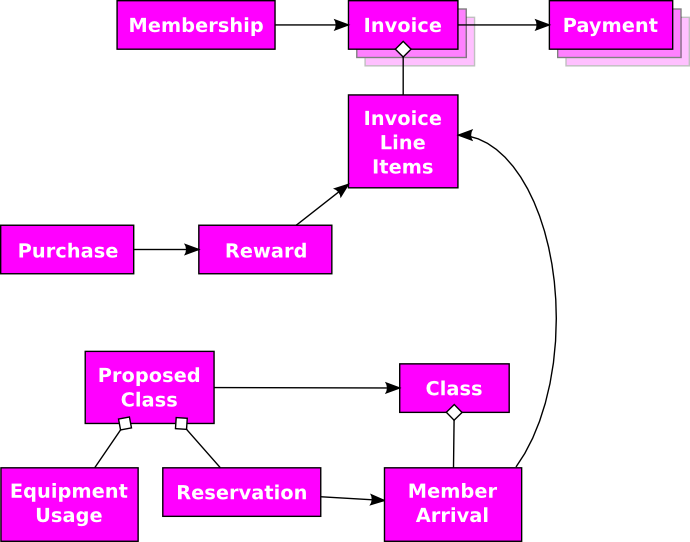
Domain-Neutral Components (DNCs) for the «moment-intervals»
To complete our domain model, we need to figure out the way in which the other classes participate in the «moment-interval»s identified and associated for our domain model.
I’ll walk through a couple of examples for how I would go about assigning the relationships. Then, I’ll just present a completed domain model for you to grok at your leisure.
I follow a simple methodology when completing the classes in a DNC:
- Identify the transactions in the system along their timelines
- Identify the participants of each of those transactions
- Determine roles needed to participate in the transactions
- Refactor common data to descriptions
The DNC for Membership
As with every exercise that involves using the Domain-Neutral Component, we start by identifying the «moment-interval» that acts as the nexus for the DNC.

The first step we color modelers should take questions the need for
«moment-interval detail»s in this DNC. As far as the requirements go, the
Membership transaction has no collection of time-related details, so we can
get rid of the placeholding pink box.
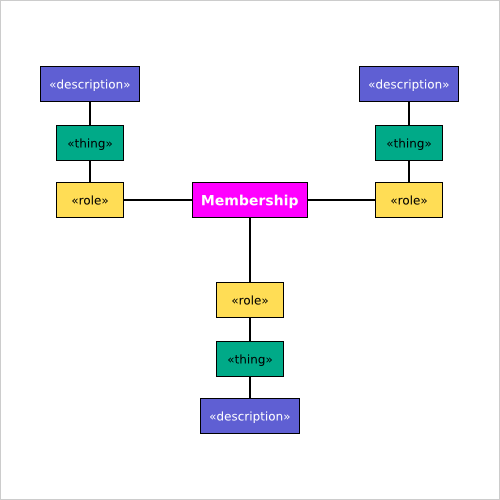
Now, as color modelers, we should determine the «thing»s that participate in the
transaction. Our thing list consists of Person, Room, and Equipment. Our
requirement reads
People join the club to become members
Conspicuously missing from our list is the Club class. In software that would
manage more than one club at a time, it would make sense to have a Club
«thing». Because we have no such requirement, Club acts as an implied
participant in every transaction.
Through a process of elimination of the available «thing»s, we conclude that the
Membership «moment-interval» has Person as its only participant.

Only «description» and «role» boxes remain. Starting with the «role», we ask,
“Does the Person play a «role» in this transaction?” Reviewing the «role»s
we’ve defined in this domain, «member» and «instructor», there’s really only one
choice, eh?

Finally, we have this concept of the «description». We must ask ourselves if we
have different groups of Persons that participate in this system. For us, we
have just people, not “rich people” and “poor people”, “smart people” or
“Tea Party members” (I just lost some of my readership…), you know,
categories of people. No. We don’t have those categories. Our system only deals
with people as
meat bags. So, we get
rid of the «description» archetype placeholder and we arrive at the
Membership DNC.
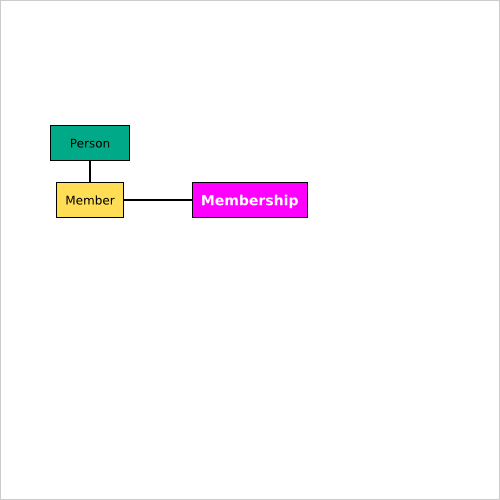
The DNC for ProposedClass
Again, general DNC time for the ProposedClass «moment-interval». Note that
the ProposedClass «moment-interval» has two types of
«moment-interval-detail»s: EquipmentUsage and Reservation.
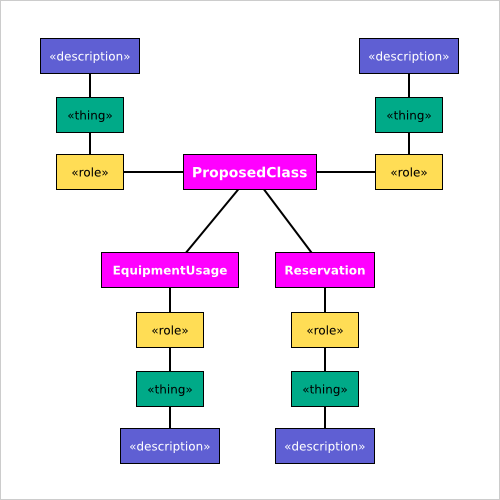
Now, let’s look at the transaction ProposedClass and ask ourselves, “Who or
what makes that transaction?” That’s a transaction between a Person acting as
an Instructor and the club. As stated before, we don’t have a specific club
class, so the «moment-interval» for ProposedClass should look like this.
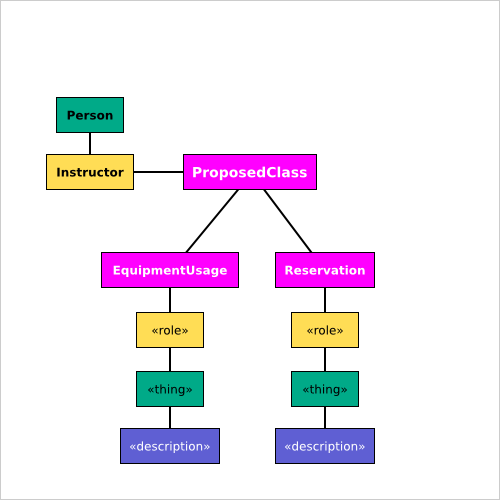
Next up, let’s look at the «moment-interval-detail» EquipmentUsage. We have a
«thing» called Equipment in our list of identified nouns. Now, a «thing»
should represent something specific in the world. No where in our requirements
do we have to do inventory tracking for balls, racquets, mats, ropes, bean bags,
and the like. So, we don’t have to track individual «thing»s. Rather, we just
need to track collections of types of equipment. That means that I have a
mistake in my initial categorization of nouns. :( So, let’s fix that.
|
Moment-Interval (Pink) Moment-Interval Detail (Pink) |
Role (Yellow) | Thing (Green) | Description (Blue) |
|---|---|---|---|
|
class invoice reward member purchase reservation member arrival membership payment |
member instructor |
person room |
equipment |
Due to that reclassification, Equipment participates in the transaction and
doesn’t need a «role» because the Equipment doesn’t change the way that it
participates in transactions. So, now we have this refined DNC.

Finally, our requirement about Reservations reads
Members RSVP for classes
So, we fill in the «role» and «thing» appropriately, get rid of the «description», and we get this.
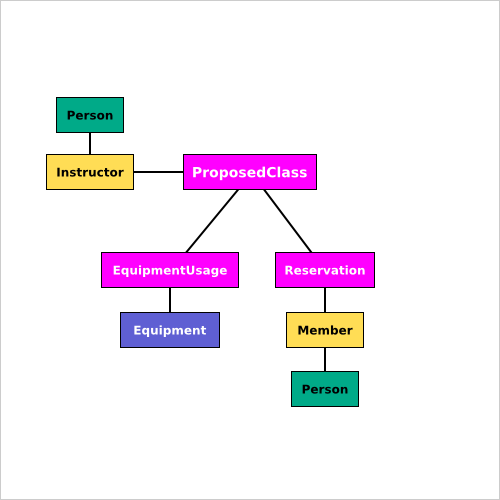
Try the rest
Left as an exercise for you for the weekend, try filling out the DNCs for each of the remaining «moment-interval»s. I’ll post my design on Monday.
Have fun!